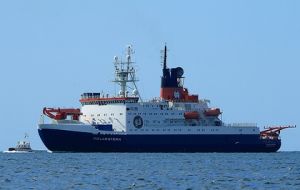MercoPress. South Atlantic News Agency
German research vessel will operate year round in Antarctica
 Polarstern, first commissioned in 1982 currently spends half its time in the Arctic and the other half in Antarctica
Polarstern, first commissioned in 1982 currently spends half its time in the Arctic and the other half in Antarctica The next five to six years will represent a great infrastructure and logistics leap forward for Antarctic activities mainly because of the greater technological advances of the scientific research vessels, according to Professor Heinz Miller a distinguished academic from Germany’s Alfred Wegener Institute for Polar and Marine Research.
“Europe is preparing the Aurora Borealis, an icebreaker which will deployed the year round in the Arctic, which at the same time will liberate Germany’s Polarstern that spends six months in each of the two poles”, said Professor Miller during an interview with La Prensa Austral from Punta Arenas in the extreme south of Chile.
The Aurora Borealis is an icebreaker specially designed in Germany which will be 65% financed with EU funds, with the Germans investing 30% in helping to pay for the rest plus operating costs.
“Actually there are thirteen countries interested in joining the project, and she should be ready to sail by 2016”, added Professor Miller.
This means that the German research vessel Polarstern, or its successor which is in the drawing board and should be completed by 2015, could be deployed the whole year in Antarctica.
“We need to research air masses in autumn, winter and spring to know how they interact with the sea, since all our research is done in the summer. We know nothing about krill in winter months and how the exchange of energy between the sea and the atmosphere gets to the sea ice, which is essential for climate research”, pointed out the German scientist.
Since she was first commissioned in 1982, the Polar stern has completed a total of more than thirty expeditions to the Arctic and Antarctic. She was specially designed for working in the polar seas and is currently the most sophisticated polar research vessel in the world.
The ship is equipped for biological, geological, geophysical, glaciological, chemical, oceanographic and meteorological research, and contains nine research laboratories. Additional laboratory containers may be stowed on and below deck. Refrigerated rooms and aquaria permit the transport of samples and living marine fauna.
Research equipment and measuring instruments are positioned with the help of cranes and winches, sometimes at extreme depths. Special sounding devices with depth ranges up to 10,000 meters and which can penetrate up to 150 meters into the sea floor are available for scientific investigations. The computer system on board continuously captures and stores meteorological, oceanographic and other data as required.
The ship has a crew of at most 44, and offers work facilities for a further 50 scientists and technicians.
The Polarstern with a maximum displacement of 17.300 tons is a double-hulled icebreaker operational at temperatures as low as –50°C, which would enable her to over winter in the ice sheets of the polar seas. Polarstern can break through ice 1.5 meters thick at a speed of approx. 5 knots.




Top Comments
Disclaimer & comment rulesCommenting for this story is now closed.
If you have a Facebook account, become a fan and comment on our Facebook Page!